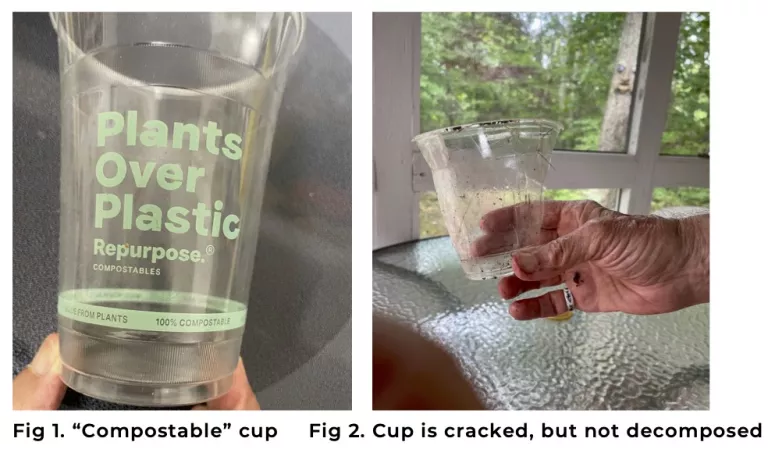by Judith S. Weis, Sierra Club NYC Group member &Professor Emerita of Biological Sciences, Rutgers - Newark Professor
About two decades ago we got a “compostable” cup at a party with green writing on it about how “green” it was because it was “compostable,” so we happily took it home and put it in our backyard composter. As of last summer it was still intact, except for the green writing, which was mostly gone.
What are Bioplastics?
They include a great variety of plastics made from biological materials, such as plants, microorganisms, lobster shells, and collagen, instead of fossil fuels, which are the base for conventional plastics. All plastics are polymers, meaning they are made up of repeated units of a smaller molecule. For example, during the process known as polymerization, many ethylene molecules (produced from fossil fuels) are strung together to form polyethylene. Among bio-derived plastics from plants is polylactic acid (PLA), which is one of the most common types. Other common bioplastics polyhydroxyalkanoates (PHA) and polyhydroxybutyrate (PHB) are made from carbon that bacteria have extracted from plants. In addition to the basic polymer, a large number of additional chemicals, or “additives,” are always included. These chemicals may make the plastic more malleable, durable, or alter its characteristics in various other ways, such as color, strength, durability, water resistance, or heat and light resistance. More than 16,000 of these chemicals, many of which have never been tested for toxicity, are used. Additives include metals such as lead and zinc, which can be neurotoxic, and persistent organic pollutants (POPs) like endocrine-disrupting bisphenols, flame retardants, PFAS and phthalates, which may affect reproduction, embryo development, and the immune system.
How well do they decompose?
While they all claim to be “compostable,” many of them, including the most common one, PLA, require industrial high temperature composting, and do not degrade in home composters, soil, or water (thus, that long-lived cup in our compost bin). Most bio-based plastics never even make it to the right kind of industrial facility needed for high temperature composting, because many areas do not have such facilities or collection programs for bio-based plastic. Thus, consumers are fooled into thinking that they are using something “green” and beneficial for the environment.
However, some types do degrade in environmental conditions. In one study, polyethylene (conventional plastic) was compared with “compostable” plastic bags (made of polybutylene terephthalate) in marine conditions. The compostable bags lost weight and tensile strength, some fragmenting in the aquaria, while the polyethylene bags did not change.

If/when they eventually decompose, how toxic are the products they decompose into, compared to conventional plastics?
Some studies have shown that the degradation products of bioplastics (BPs) are about as toxic as those of conventional plastics (CPs), although there are studies in which bioplastic degradation products had either higher or lower toxicity. These different results are due to scientists studying different bioplastics, comparing them with different conventional plastics, testing the effects of the toxicity on different species, and examining different responses. In addition, some studies used large pieces of plastic while others used thin films, microplastics (MPs), or leachates from the plastics. Therefore, it is hard to conclude overall whether BPs are more or less toxic than CPs, but they seem to be as toxic to human health and the environment as CPs.
However, the majority of studies, using plants, small freshwater or marine invertebrates, worms, etc., seem to indicate greater toxicity in the bio-based plastics. Because the commonly used plant-based PLA, PHA and PHB are brittle and lack durability, they require a large number of added chemicals and probably leach more chemicals than conventional plastics because they contain more chemicals. A study in 2020 found that chemical mixtures in biodegradable or BP products can alter the metabolic activity of bacteria, and cause stress in other organisms. They extracted 43 different BPs and analyzed their toxicity. Two-thirds of the samples induced baseline toxicity, 42% produced oxidative stress, and 23% contained endocrine disruptors known to impair male hormones.(1) They detected 41,395 chemicals, including 343 “compounds of concern.”
BPs are more likely than CPs to degrade into microplastics and release their additives. Scientists found the rougher surface of bio-based microplastics (BMPs) increases the likelihood of fragmenting into smaller particles, thereby releasing more additives and leading to greater toxic effects. In addition, plastics can pick up environmental chemicals such as metals, PCBs, and other harmful organic chemicals from water or air, and later transfer them into animals that eat or breathe them in, thus acting as a “vector” for moving these chemicals into organisms. In terms of being vectors for environmental chemicals, BMPs appear to be more effective carriers than conventional MPs, with a greater capacity to accumulate and transfer pollutants in the environment. Another recent review had similar conclusions, finding that BPs tend to deteriorate into BMPs more rapidly than conventional plastic and that BMPs have comparable or greater toxic effects compared to conventional microplastics (CMPs).(2)
Conclusions:
The terms “compostable” and “biodegradable” cause consumers to think that a product is safe and is truly compostable. However, bio-based or bioplastics are not “green” or compostable at normal temperatures, and their break-down products are often more toxic than conventional plastics. They do not provide a solution to plastic pollution, but instead they just add to the problems.
Notes:
(1): Zimmermann, L., Dombrowski, A., Völker, C., & Wagner, M. (2020). Are bioplastics and plant-based materials safer than conventional plastics? In vitro toxicity and chemical composition. Environment International, 145, 106066. https://doi.org/10.1016/j.envint.2020.106066
(2): Fan, P., Yu, H., Xi, B., & Tan, W. (2022). A review on the occurrence and influence of biodegradable microplastics in soil ecosystems: Are biodegradable plastics substitute or threat? Environment International, 163, 107244. https://doi.org/10.1016/j.envint.2022.107244